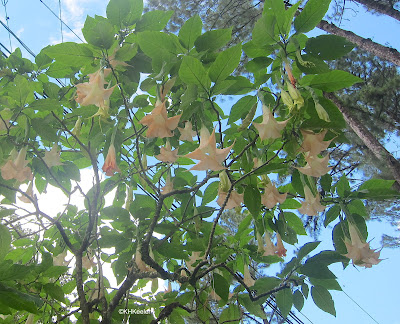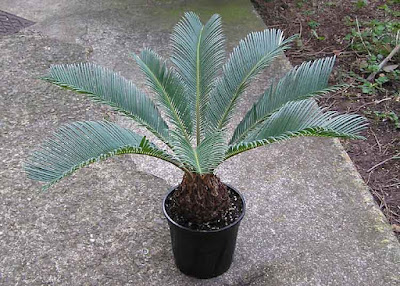 |
| wisteria, not very toxic |
Plants can be poisonous. A very few are so deadly that a bite will kill a healthy adult. Other plants will upset your stomach. More plants just don't taste very good. Sloppy reporting of plant dangers offends me.
Sometimes the problem is exaggerating dangers:
Wisteria (Wisteria species, pea family, Fabaceae, photo above) will upset the stomach when eaten (vomiting, diarrhea) but if you look, there are zero, zip, no reports of human deaths and very few (three I could find) reports of hospitalization worldwide, over all history, including the past 50 years of good record-keeping. The animal literature looks similar: reports of vomiting or diarrhea in dogs or horses but not of deaths. So it is irresponsible for websites to say "fatal to dogs and small children." Save that rhetoric for plants that have actually killed people, for example, foxglove (Digitalis link).
 |
| Seriously toxic, foxglove, Digitalis |
A key point about plant poisins is that virtually all require you to consume a plant part. If you don't eat it, it won't poison you.
Some plants cause skin reactions, others are spiny, but again, don't touch the plant and you are perfectly safe.
One or two plants (of 320,000) release toxins into the air in amounts that can sicken people. The one I know of is Brugmansia, the angel's trumpet (potato family, Solanaceae) (more: link); the sweet smell can cause dizziness, headaches, nausea, and irritation of throat and lungs, assuming you linger under them or sit in a closed room with a bouquet of the flowers. However, this does not appear to affect everyone the same; some people love the scent and South American folklore recommends the scent to induced sleep for insomniacs. In a world of hundreds of thousands of plants, contactless poisoning is extremely rare (perfect for your next murder mystery).
 |
| Walking under angel's trumpet, Brugmansia |
A second set of problems are caused by generalizing from the common name:
Common names do not reflect, well, much of anything. So making statements about toxicity from one plant, based on its common name, to others with similar names is appalling. For example, lily is a genus, Lilium, in the lily family, Liliaceae, but many plants have common names with lily in them, for example daylilies (Hemerocallis) and starlily (Leucocrinum). Many lilies, those in the family Liliaceae, are quite poisonous. However, in modern classification, daylilies are in the aloe family, the Asphodellaceae, and starlilies in the agave family Agavaceae, and both are more closely related to asparagus than lilies. Daylilies, in particular, should not be described as toxic just because lily is in their name. Asians have eaten tawny daylilies (Hemerocallis fulva) for millennia. (I know you can read authoritative veterinary sources that say daylilies are dangerous to cats. I looked at the data, so far as it is available to a non-veterinarian, and it is good veterinary medicine but poor botany--plants were not identified except by what the owner said. There was no documentation for plant identification and usually the plant could easily have been Lilium not Hemerocallis. I tried to work with the ASPCA to get better data, but they never quite came through. )
Common names do not reflect, well, much of anything. So making statements about toxicity from one plant, based on its common name, to others with similar names is appalling. For example, lily is a genus, Lilium, in the lily family, Liliaceae, but many plants have common names with lily in them, for example daylilies (Hemerocallis) and starlily (Leucocrinum). Many lilies, those in the family Liliaceae, are quite poisonous. However, in modern classification, daylilies are in the aloe family, the Asphodellaceae, and starlilies in the agave family Agavaceae, and both are more closely related to asparagus than lilies. Daylilies, in particular, should not be described as toxic just because lily is in their name. Asians have eaten tawny daylilies (Hemerocallis fulva) for millennia. (I know you can read authoritative veterinary sources that say daylilies are dangerous to cats. I looked at the data, so far as it is available to a non-veterinarian, and it is good veterinary medicine but poor botany--plants were not identified except by what the owner said. There was no documentation for plant identification and usually the plant could easily have been Lilium not Hemerocallis. I tried to work with the ASPCA to get better data, but they never quite came through. )
 |
| lilies, Lilium, poisonous |
 |
| daylilies, Hemerocallis Not a lily and not closely related to lilies, notice differences in flower clusters, petals, and leaves... |
It cuts the other way, too. Although we eat black beans (Phaseolus vulgaris) and lima beans (Phaseolus lunatus), do not eat jequirity beans (Abrus precatorius, bean family Fabaceae) and castor beans (Ricinus communis, spurge family, Euphorbiaceae) they are very poisonous.
 |
| lima beans, Phaseolus lunatus, food plant |
 |
| castor bean, Ricinus communis, poisonous |
Close relatives may share toxins, though they don't always, but sharing a common name with a plant gives absolutely no information about the safety of the second plant. Which is not to promise that not being a true lily makes a plant safe to eat, of course not.
Plants do contain toxins and a few are poisonous, but most plants that I'd warn you not to eat simply cause an upset stomach. You'd have to eat a soup-bowlful to get really sick, and the flavor would stop you long before that. The dose makes the poison and very few (but not no) plants have poisons that are life-threatening in small doses. People work safely for years in the same room with a plant that could kill them. For example, sego palm (Cycas revoluta, not a palm but a cycad Cycadaceae), is one of the few genuinely poisonous plants used as an office ornamental (link, link). Don't eat it.
There is no need to run in fear of plants and no need for the internet to exaggerate their dangers. I think over-selling dangers is common, perhaps out of caution. Yet the internet is such a wonderful reference tool; we should get the information right! It may be improving, but it has a ways to go. For now, be skeptical! The observation that sent me searching for verification of wisteria toxicity was reading that a traditional holiday treat in China was a wisteria cake.
I hate misinformation.

As they say, a little knowledge is sometimes worse than no knowledge at all. I'm always scared of my wife picking up and eating something from our hike, just because it looks like something edible from the market. This goes double for any mushroom.
ReplyDeleteGreat topic, and rant, thank you, I agree...it is not hard to take a few minutes to google "toxicology" + the binomial plant name.
ReplyDeleteGreat blog post, thank you. I am finally finding time in my life to get back into the study of medicinal and edible plants. If you want to get serious about it, I highly recommend tracking down botanical names and procure as many reputable books on th topic that you can get your hands on. One can find people like you, KH Keeler, who are kind enough to share your knowledge online, but so many articles are just some regurgitation of other lightly researched posts. Very annoying, 'Google' isn't what it used to be! (Anyone else remember when you could still access university databases and libraries online? Those were the good ol' days.)
ReplyDeleteWondering if this sentence is missing an important word: "...castor beans (Ricinus communis, spurge family, Euphorbiaceae) are safe eat, in fact they are very poisonous."
ReplyDeleteThe sentence was fine...it went "just because these beans are safe, don't think these other are safe to eat, in fact they are very poisonous." But given the way search engines grab phrases, I take your point and revised the sentence.
Delete